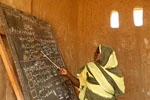
Last week, UNESCO, the United Nations Education, Scientific and Cultural Organization, released its annual Education for All Global Monitoring Report, "The Hidden Crisis: Armed Conflict and Education." Despite improvement in many areas, according to the report, 67 million primary school age children were not enrolled in 2008, 28 million of those in conflict-affected countries.
The report mentions multiple failings of the international community to match the resolve of those affected by violence and who struggle to continue their educations. To address the challenges of education in conflict areas, the report calls for four key actions: strengthening protection for children against human rights violations, boosting humanitarian aid for education, increasing support for peacebuilding and reconstruction, and utilizing education as a mechanism for peace, by developing inclusive education systems.
Only two percent of global humanitarian aid goes toward education, and the report demonstrates that it’s not nearly enough. “No sector has a bigger shortfall between requests for humanitarian aid and delivery of humanitarian aid,” said Kevin Watkins, the director of the report, in an accompanying video.
The experience of children in conflict was also the subject of a report last month by Amnesty International, on the use of children in armed conflict in Chad. The lack of educational opportunities for refugees and the internally displaced in eastern Chad contributes to a tragically ideal scenario child-soldier recruitment, according to the Amnesty report.
Increased support for education in the face of armed-conflict is critical to breaking the cycles of violence and stagnation in human development around the world – a theory that motivates the Darfur Dream Team’s work in eastern Chad. By linking up students in the United States with Darfuri refugee students through the Sister Schools program, the Darfur Dream Team aims to match the resolve of Darfuri refugees aspiring for education in eastern Chad. Learn more about the Sister Schools program and how you can support these efforts.

